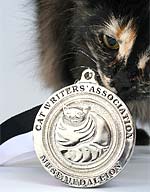 |
|||||||||||||||||||
|
|

We are the proud winners of the 2006 - 2009 winner of the Muse Medallion for Online Magazine by The Cat Writers? Association in their annual Communications Contest! (Photo courtesy of Weems Hutto).
On November 17, 2007 Felinexpress.com was honored to receive The President's Award by the Cat Writers' Association. We are very proud to have earned this distinction and will continue to provide quality information for all cat lovers.
Felinexpress.com home > Cat Care > The Great Cat Food Debate |
The Great Cat Food Debate
Next time you find yourself on the cat food aisle of your local grocery store or pet supply warehouse, take a good look around. Check out all vibrant colors displayed on each bag of cat food vying for your attention. Each company is banking on your eyes being drawn to their product, for the pet food industry is a highly competitive market. The choice can be as confusing as stepping into the cereal aisle and being bombarded by colors, tempting offers of toys or being told there is 20% more product available at the same cost. So which brand of cat food do you buy?
Most veterinarians if asked will assure you that in the commercial cat food business the overall quality and contents are good. Yet their shelves in the clinic will only display specific branded cat food. These foods are targeted specifically for particular health issues; CRF, hairball problems, obesity, heart issues, and poor digestion to name a few. Commercial cat food rarely becomes that specialized as the food is made from independent plants who win contracts from the pet food industry.
Some dry cat food bags are labeled as “Complete” while others will say “Balanced.” What’s the difference?
The complete cat food contains all the nutrients your cat needs within each piece of the kibble produced. Balanced means that you would feed your cat certain amounts of the food based on your cat’s energy requirements. To add to the cat food confusion, some bags and even canned foods claim to be Complete and Balanced.
Which cat food is right for my cat?
Available for purchase are cat foods for all stages of your cat’s life; kitten, young adult, adult, or senior plus the aforementioned specialty brands. In the grocery stores, you will find all-purpose cat food being sold with only a few specialty brands thrown into the mix. To find the higher quality (and more expensive) cat food brands, or specialized brands, you will need to look at vet clinics, pet supply warehouses, pet stores or online.
Which cat food is better wet cat food or dry cat food?
When you consider a cat’s origin, they were desert creatures. In their natural habitat, they survived on rodents, bugs and small prey. These kills were high in protein with ample amounts of minerals, fat and a bit of carbohydrates. These substances sustained the energy requirements for growth and maintenance. All of their prey consisted of high amounts of moisture and the cats wasted very little of their kill. This moisture aided the cat in the ability to digest the prey without digestive upset, lubricate limbs, joints and tissue and helped the cat to regulate its temperature.
In canned food, the moisture content is generally 75%-85%. The shelf life on a can of unopened canned cat food is longer than on a bag of dry cat food. Open up that can and the shelf life diminishes. The food needs to be eaten in three days. In a bag of dry cat food, the moisture content is 10%. Along with dry or canned cat food, your cat should be given fresh water daily.
Should I add water to dry cat food?
Care should be taken when you add water to dry cat food especially if you free-feed. If you intend on leaving the dry food out for an extended amount of time, you need to be aware that airborne bacteria can settle on the food and create digestive upset; vomiting and diarrhea for your cat. The bacteria is commonly found in soil and makes its way into the food by the introduction of the grains, cereals, meal and other fillers used in the cat food. If this dry food is moistened with water and left out for long periods during the day, these bacteria will settle and grow on the food.
If you moisten your dry cat food, only leave it out for thirty minutes. You can mix the wet cat food with the dry cat food this will prompt most cats to eat the food quicker and provide more moisture. But this mixture will also draw in bacteria if left out.
Why do some dry cat foods contain dyes?
When cat food comes out of the hopper, it resembles a flat sheet of bread dough. Then it is broken up into particles. These particles are the color of charcoal which is not very appetizing for our eyes (although the cats wouldn’t care). The pet food manufacturers add dyes to the mix as a marketing ploy. Just like a box of TRIX, the more colorful the better. Some of these dyes on the cheapest brands may cause digestive upset.
On a personal note:
In my multi-cat home, I feed a grocery store brand that doesn’t end up in wet piles on my carpet. I feed what my cats eat. One of my cats, a finicky calico will not eat any other brand of dry food but one specific brand, nor will she eat wet cat food.
When a new cat arrives or a resident cat becomes ill and for health reasons won’t eat the regular food, I turn to a gourmet brand of cat food. I affectionately call this brand of cat food “kitty crack.” I have yet to find a cat or kitten who won’t eat it. I also keep a sharp eye on the watchdog websites for lists of dry and wet cat food that makes the contaminated lists.
It is an individual choice whether or not to feed wet cat food or dry cat food or a combination of both or to go raw. Keeping your cat’s well-being and nutritional needs in mind while making informed choices of what to feed, how much to feed and how often to feed can be determined by reading labels and talking over diet restrictions with your vet.
If you decide to change your cat’s diet, do so slowly. Introduce the new food within a few days by mixing it in small amounts with their regular food. This will stop any digestive upset.If your cat still refuses the food switch to a large saucer or dinner plate. Cat’s whiskers are very sensitive and if the cat bumps his whiskers against a food bowl, he may stop eating altogether.
Don’t be taken in by the vibrant colors on the bags and other marketing strategies. Read each label closely and determine your cat’s needs. What is his activity level? Age is also a determining factor along with health concerns. Some cat foods are comprised of mostly vegetables- when was the last time you saw your cat eating a sweet potato? They are obligate carnivores, meaning they need meat. Keep that in mind next time you are shopping the cat food aisles.
More cat breeds |
|
? Copyright 2006-2010 Felinexpress.com, All Rights Reserved
Privacy Statement - Disclaimer - About Me


